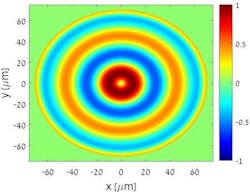Ultrasound-producing fiber sensors can now operate with a coated fiber
Optical fiber sensing supports measurements over hundreds of kilometers and can be embedded in almost any structure, operate in hazardous environments, and withstand electromagnetic interference. Recently a major breakthrough in optical fiber sensors helped enable measurements of liquids outside the boundary of the glass fiber, even though guided light in the glass-clad fiber never reaches the outside environment (not even the evanescent waves).
Such seemingly paradoxical measurements are based on optomechanics, in which the propagation of light induces ultrasonic waves in the optical fiber, which in turn can probe the surroundings of the fiber, similar to ultrasonic imaging that is common in medical diagnostics. The analysis of liquids outside kilometer lengths of fiber was reported independently by researchers from Bar-Ilan University (Ramat Gan,, Israel) and the École polytechnique fédérale de Lausanne (EPFL; Lausanne, Switzerland).
The results obtained to date have all suffered, however, from one major drawback: the protective polymer coating of the glass fiber had to be removed first. Without such a protective coating, or jacket, bare fibers of 125 μm diameter do not stand much chance. One cannot consider the application of kilometers-long unprotected optical fibers outside the research lab. Unfortunately, the standard fiber jacket is made with an inner layer of acrylic polymer that is extremely compliant and that completely absorbs ultrasonic waves emerging from the optical fiber, keeping them from reaching any media under test. The presence of coating represents one more barrier that the sensor concept must overcome.
Polyimide jacket transmits ultrasound
The solution to this challenge comes in the form of a different, suitable coating. Commercially-available fibers can also be protected by a jacket made of polyimide. Polyimide has long been used for protecting optical fiber at high temperatures. Now, studies at Bar-Ilan and EPFL have demonstrated that the polyimide coating also provides transmission of ultrasound. The consequences are significant: researchers at Bar-Ilan University report that they can now perform optomechanical sensing and analysis of media that lie outside protected fibers.1
"Our analysis shows that the optomechanical behavior is much more complex than that of a bare fiber," says Avi Zadok from Bar-Ilan University. "The results strongly depend on submicron tolerances in the thickness and geometry of the coating layer. A proper form of calibration is mandatory."
Despite this added difficulty, the mapping of liquids outside coated fibers has been demonstrated experimentally. The group achieved sensing over 1.6 km of polyimide-coated fiber immersed in water for most of its length. A 200-m-long section, however, was kept in ethanol instead. The measurements distinguish between the two liquids, and properly locate the section placed in ethanol.
"One possible application is the monitoring of irrigation," says Zadok. "The presence of water modifies the properties of the coating. Our measurements protocol is able to identify such changes."
Ongoing work is dedicated to improving the range, resolution, and precision of the measurements.
Source: https://www.eurekalert.org/pub_releases/2019-01/bu-fsm012819.php
REFERENCE:
1. Amelia Jaycen, AIP Scilight (2019); https://doi.org/10.1063/1.5089954.
About the Author
John Wallace
Senior Technical Editor (1998-2022)
John Wallace was with Laser Focus World for nearly 25 years, retiring in late June 2022. He obtained a bachelor's degree in mechanical engineering and physics at Rutgers University and a master's in optical engineering at the University of Rochester. Before becoming an editor, John worked as an engineer at RCA, Exxon, Eastman Kodak, and GCA Corporation.

